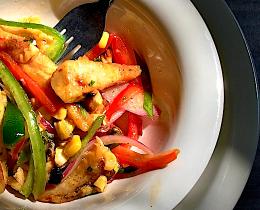You’ve come home late after work.
You’re tired. You’re hungry.
You open the fridge, and there they are—the leftovers from yesterday’s takeout.
Hooray! Easy peasy. You grab the container, pop it in the microwave, and presto—dinner in the time it takes to slip on sweatpants.
But wait! Did you consider what the container is made from?
Were you aware studies have shown that when exposed to common-use stresses like microwaving, almost all commercially available plastic products leech chemicals that impact estrogenic activity, including plastic products advertised as being free of Bisphenol A (BPA)?
Did you know that some acidic foods, when heated to high temperature, can absorb melamine, a chemical used in the manufacture of some cooking utensils, plates, plastic products, paper, paperboard, and industrial coatings? Too much melamine can cause conditions such as kidney stones and kidney failure.
Yikes.
The food in our kitchens is often surrounded by plastic, ranging from the packaging it came in, to the kitchenware and appliances we use to prepare it, to the containers in which we store it.
Avoiding all plastic in the kitchen is nearly impossible.
However, a little knowledge can go a long way toward mitigating risks.
Understanding Plastic Types
First, get to know plastic. Not all types are the same.
Plastic types can be identified via the resin identification code—the number, surrounded by arrows, that is stamped on plastic items.
Some types carry more risks than others.
A container marked with the number 3 or the letters PVC contains polyvinyl chloride, part of a class of chemicals called phthalates, according to St. Joseph Health, a health network based in Irvine, California. “Researchers believe phthalates may leach from plastic containers into our food, like BPA does,” Lisa Gorman, director of worksite wellness at St. Joseph Health, said.
Plastic marked with the number 6 contains polystyrene, a petroleum-based plastic. Exposure to unsafe levels of styrene can affect the nervous system and potentially cause cancer, according to the Centers for Disease Control and Prevention.
Number 7 plastic can be tricky. This designation is a catch-all for all other plastic types. It includes compostable, bio-based products that are considered more safe, as well as those made with polycarbonate, which contains BPA. You'll need to do a little digging to determine which type is contained in a particular item, though bio-based products typically are marked as such.
A good rule of thumb: If you buy a hot roasted chicken at your grocery store, take it out of the plastic container as soon as possible.
Distressingly, BPA is found not just in plastic containers. It is also used as a rust-preventive coating in some canned foods. Jar lids and bottle caps can also have these coatings.
Some companies sell canned foods that don’t have these linings, but they are rare.
Which Plastic Is Safest?
There are some plastics that have been shown to be safer, with lower risks of leeching.
Several sources, including the state of Illinois, identify three types to be the safest:
- Type #2: High density polyethylene (HDPE). This cloudy plastic is commonly used in milk jugs.
- Type #4: Low density polyethylene (LDPE). This type is typically found in squeezable bottles, shopping bags, clothing, carpet, frozen food, bread bags, and some food wraps.
- Type #5: Polypropylene (PP). This is found in yogurt containers, ketchup bottles, syrup bottles, and medicine bottles.
Of course, there is a simple way to eliminate all of the guesswork—find alternatives to plastic.
These range from obvious storage options such as glass containers to stainless steel bowls and even reusable food wraps made from cotton cloth infused with beeswax, tree resins, and essential oils.
Indeed, it is oddly reassuring that one of the safest storage vessels traces its history back to 1858.
That's the year a patent was issued for a newfangled container that bore the name of its inventor and was honored 100 years later with a centennial collection in the Library of Congress.
The inventor of the jar was John L. Mason.



